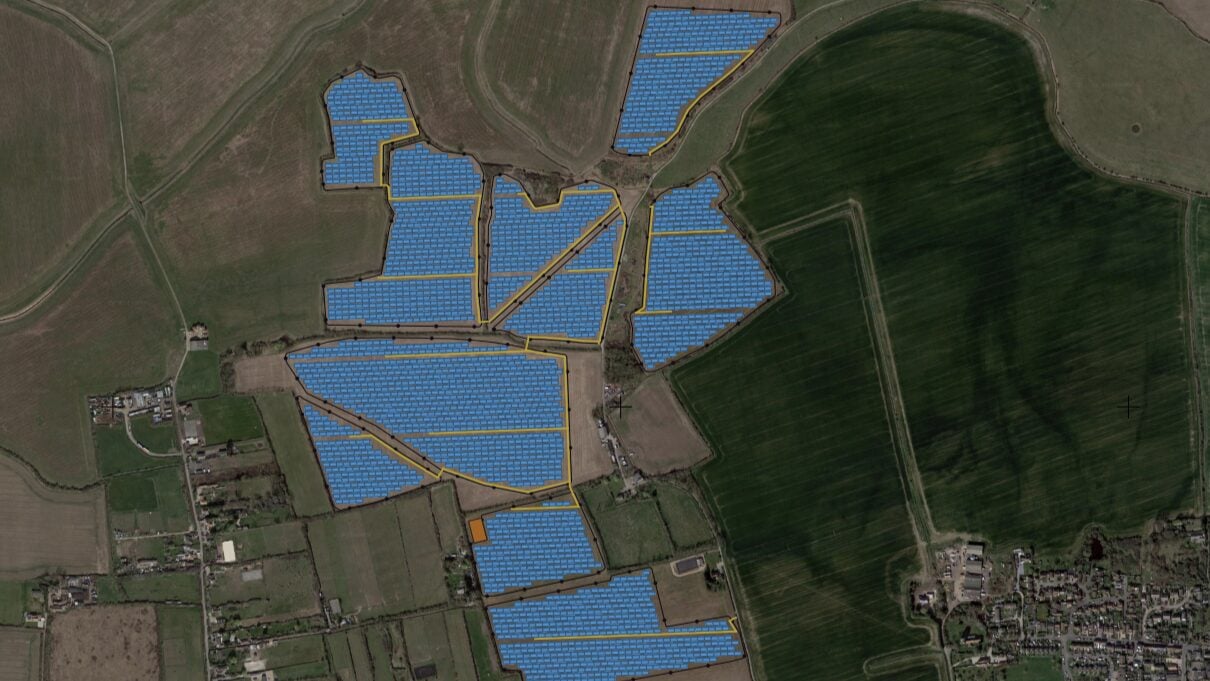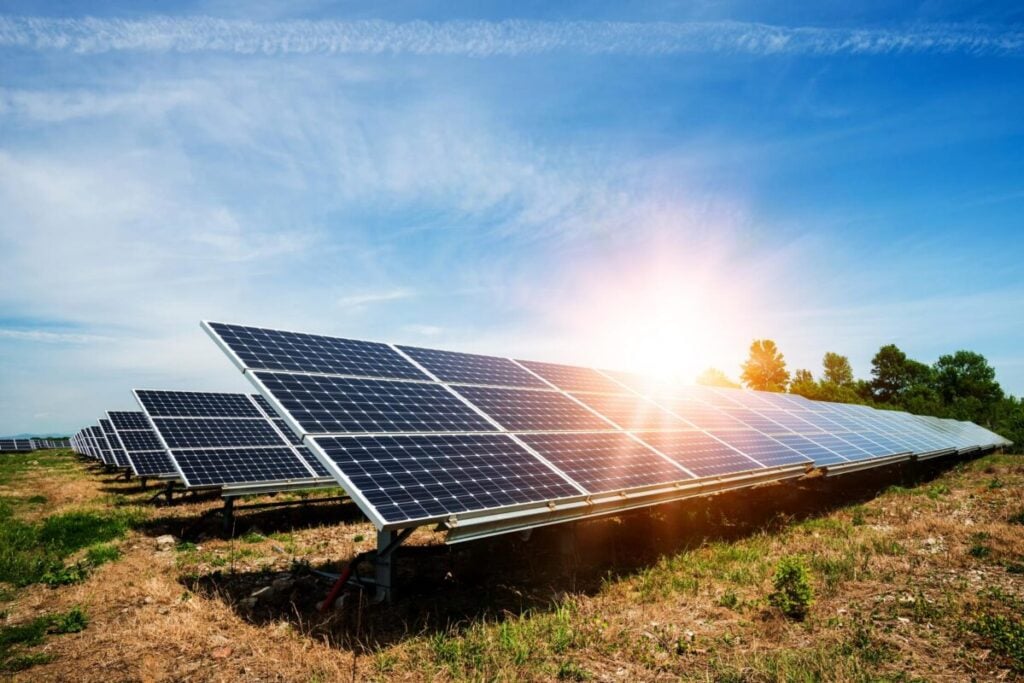Solar mount system material selection
1. In terms of material strength
Solar mount system generally use Q235B steel and aluminum alloy extruded profiles 6063 T6. In terms of strength, 6063 T6 aluminum alloy is about 68%-69% of Q235 B steel, so steel is generally better than aluminum in strong wind areas and large spans. Alloy profiles.
.jpg) 2. Deflection deformation
2. Deflection deformation
The deflection deformation of the solar mount system structure is related to the shape and size of the profile and the elastic modulus (a parameter inherent to the material), and has no direct relationship with the strength of the material. Under the same conditions, the deformation of aluminum alloy profiles is 2.9 times that of steel, and the weight is 35% of that of steel. In terms of cost, under the same weight, aluminum is 3 times that of steel. Therefore, steel is generally better than aluminum alloy profiles in strong wind areas, relatively large spans, and cost.
The aluminum alloy is in the passivation zone in the atmospheric environment, and a dense oxide film is formed on the surface, which prevents the surface of the active aluminum substrate from contacting the surrounding atmosphere, so it has very good corrosion resistance, and the corrosion rate increases with time. and decrease.
Under ordinary conditions (C1-C4 environment), the thickness of 80μm galvanized steel can be guaranteed to be used for more than 20 years, but in high humidity industrial areas or high salinity seashores or even temperate seawater, the corrosion rate is accelerated, and the amount of galvanizing needs 100μm, above and require annual regular maintenance.
Aluminum alloys are far superior to steel in terms of corrosion resistance.
4. Contrast corrosion in other aspects
1) Appearance:
There are many surface treatment methods for aluminum alloy profiles, such as anodizing, chemical polishing, fluorocarbon spraying, electrophoretic painting, etc. It has beautiful appearance and can adapt to various environments with strong corrosive effect.
Steel is generally hot-dip galvanized, surface spraying, paint coating and other methods. The appearance is worse than that of aluminum alloy profiles. It is also inferior to aluminum profiles in terms of corrosion resistance.
2) Section diversity
The general processing methods of aluminum alloy profiles include extrusion, casting, bending, stamping, etc. Extrusion production is the current mainstream production method. By opening the extrusion die, profiles of any arbitrary cross-section can be produced, and the production speed is relatively fast.
Steel is generally rolled, cast, bent, stamped and so on. At present, rolling is the mainstream production method for producing cold-formed steel. The section needs to be adjusted by the rolling wheel set, but generally, the machine can only produce similar products after finalization, and the size can be adjusted, but the section shape cannot be changed, such as C-section steel, Z-section steel and other sections. The rolling production method is relatively fixed and the production speed is relatively fast.
5. Material recycling
The maintenance cost of the steel structure increases by 3% every year, while the aluminum structure solar bracket hardly needs any maintenance and maintenance, and the aluminum material still has a 65% recycling rate after 30 years, and the aluminum price is expected to increase by 3% every year. After 30 years, it is basically a pile of scrap iron with no recycling value.
6. Comprehensive performance comparison
1) The aluminum alloy profile is light in weight, beautiful in appearance and excellent in corrosion resistance. It is generally used in household roof power stations and strong corrosive environments that require load-bearing.
2) The steel has high strength and small deflection and deformation under load. It is generally used in ordinary power stations or components with relatively large forces.
3) Cost: In general, the basic wind pressure is 0.6kN/m2 and the span is less than 2m. The cost of aluminum alloy solar brackets is 1.3-1.5 times that of steel structure solar brackets. In the small-span system (such as color steel plate roof), the cost difference between aluminum alloy solar brackets and steel structure solar brackets is relatively small, and aluminum alloys are much lighter than steel brackets in terms of weight, so they are very suitable for home roof power stations.
Solar mount system generally use Q235B steel and aluminum alloy extruded profiles 6063 T6. In terms of strength, 6063 T6 aluminum alloy is about 68%-69% of Q235 B steel, so steel is generally better than aluminum in strong wind areas and large spans. Alloy profiles.
.jpg)
The deflection deformation of the solar mount system structure is related to the shape and size of the profile and the elastic modulus (a parameter inherent to the material), and has no direct relationship with the strength of the material. Under the same conditions, the deformation of aluminum alloy profiles is 2.9 times that of steel, and the weight is 35% of that of steel. In terms of cost, under the same weight, aluminum is 3 times that of steel. Therefore, steel is generally better than aluminum alloy profiles in strong wind areas, relatively large spans, and cost.
3. Anti-corrosion
At present, the main anti-corrosion method of solar mount system is hot-dip galvanized steel with 55-80μm, and aluminum alloy with anodized 5-10μm.The aluminum alloy is in the passivation zone in the atmospheric environment, and a dense oxide film is formed on the surface, which prevents the surface of the active aluminum substrate from contacting the surrounding atmosphere, so it has very good corrosion resistance, and the corrosion rate increases with time. and decrease.
Under ordinary conditions (C1-C4 environment), the thickness of 80μm galvanized steel can be guaranteed to be used for more than 20 years, but in high humidity industrial areas or high salinity seashores or even temperate seawater, the corrosion rate is accelerated, and the amount of galvanizing needs 100μm, above and require annual regular maintenance.
Aluminum alloys are far superior to steel in terms of corrosion resistance.
4. Contrast corrosion in other aspects
1) Appearance:
There are many surface treatment methods for aluminum alloy profiles, such as anodizing, chemical polishing, fluorocarbon spraying, electrophoretic painting, etc. It has beautiful appearance and can adapt to various environments with strong corrosive effect.
Steel is generally hot-dip galvanized, surface spraying, paint coating and other methods. The appearance is worse than that of aluminum alloy profiles. It is also inferior to aluminum profiles in terms of corrosion resistance.
2) Section diversity
The general processing methods of aluminum alloy profiles include extrusion, casting, bending, stamping, etc. Extrusion production is the current mainstream production method. By opening the extrusion die, profiles of any arbitrary cross-section can be produced, and the production speed is relatively fast.
Steel is generally rolled, cast, bent, stamped and so on. At present, rolling is the mainstream production method for producing cold-formed steel. The section needs to be adjusted by the rolling wheel set, but generally, the machine can only produce similar products after finalization, and the size can be adjusted, but the section shape cannot be changed, such as C-section steel, Z-section steel and other sections. The rolling production method is relatively fixed and the production speed is relatively fast.
5. Material recycling
The maintenance cost of the steel structure increases by 3% every year, while the aluminum structure solar bracket hardly needs any maintenance and maintenance, and the aluminum material still has a 65% recycling rate after 30 years, and the aluminum price is expected to increase by 3% every year. After 30 years, it is basically a pile of scrap iron with no recycling value.
6. Comprehensive performance comparison
1) The aluminum alloy profile is light in weight, beautiful in appearance and excellent in corrosion resistance. It is generally used in household roof power stations and strong corrosive environments that require load-bearing.
2) The steel has high strength and small deflection and deformation under load. It is generally used in ordinary power stations or components with relatively large forces.
3) Cost: In general, the basic wind pressure is 0.6kN/m2 and the span is less than 2m. The cost of aluminum alloy solar brackets is 1.3-1.5 times that of steel structure solar brackets. In the small-span system (such as color steel plate roof), the cost difference between aluminum alloy solar brackets and steel structure solar brackets is relatively small, and aluminum alloys are much lighter than steel brackets in terms of weight, so they are very suitable for home roof power stations.



